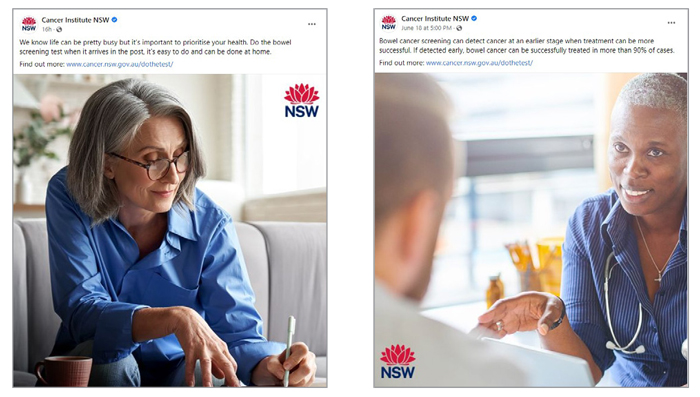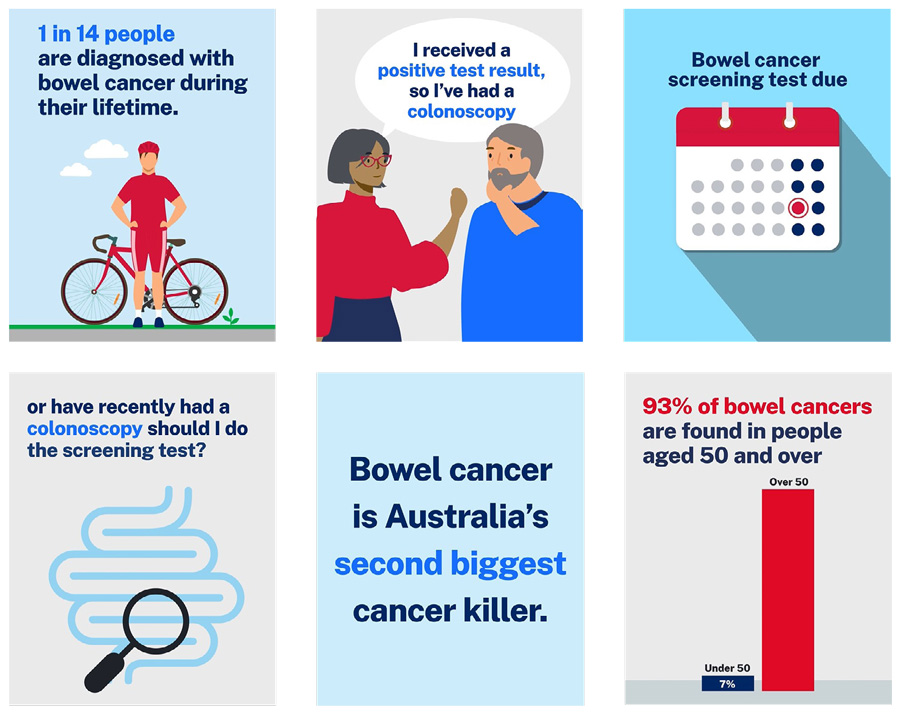Social Media Campaign
2022/23 Bowel Cancer Screening Social Media Campaign
- Campaign overview
- Why we need a campaign
- Social media channel
- Target audience
- Key messages
- Campaign assets
Campaign overview
Cancer Institute NSW is delivering the 2022/23 Bowel Cancer Screening Social Media Campaign to encourage customers to engage with and seek more information about the National Bowel Cancer Screening Program (NBCSP) and to increase awareness of bowel cancer screening key messages.
The campaign, targeted to people in NSW aged 50–74, will run from July 2022 to June 2023 via the Cancer Institute NSW social media channels.

Why we need a campaign
Bowel cancer is the second biggest cancer killer in NSW.1 It is estimated that approximately 102 people die nationally each week from bowel cancer2, with approximately 35 of these being in NSW.3
The bowel cancer screening test is highly effective in detecting bowel cancer early, when it can be successfully treated in more than 90% of cases.4 Unfortunately, only 40% of eligible people in NSW are doing the NBCSP test when they receive it in the post. NSW has the second lowest national participation rate.5
Social media channel
Previous social media campaigns have been effective in motivating eligible people to engage with the Cancer Institute NSW social media channels. In 2021/22, Facebook and Instagram advertising delivered 54,000 website landing page views, 13,000 social engagements and 83,000 clicks.
The NBCSP target audience aligns strongly with the Facebook audience, and Facebook has the potential to reach 1.4 million people aged 50–65+ in NSW.
Target audience
The campaign targets people in NSW aged 50–74, with a focus on:
- Aboriginal people, who are 2.3 times less likely to screen for bowel cancer than non-Indigenous people.6
- Arabic, Cantonese and Mandarin speakers, who make up a large proportion of this age group,7 have a low level of English language proficiency,8 and low bowel screening rates.9
Key campaign messages
- Bowel cancer is Australia’s second biggest cancer killer.1
- If detected early, bowel cancer can be successfully treated in more than 90% of cases.4
- A bowel cancer screening test will be posted to people aged 50–74 every two years.
- Do the test when it comes in the post.
Campaign assets
The 2022/23 Bowel Cancer Screening Campaign uses clear, factual ads to educate people aged 50–74 about bowel cancer and the NBCSP. The ads aim to motivate eligible people to do the bowel cancer screening test when it arrives in the post.
See below some examples of the asset types used in the campaign, or visit our Facebook page.
Further information
- For further information about the campaign and our work to reduce bowel cancer deaths through early detection, download cancer.nsw.gov.au/2022-bowel-cancer-toolkit
- Or contact us directly at: cinsw-bowelscreening@health.nsw.gov.au
1. Cancer Institute NSW. (2021). Cancer statistics NSW webpage: https://www.cancer.nsw.gov.au/research-and-data/cancer-data-and-statistics/cancer-statistics-nsw#// Accessed: December 2021.
2. Australian Institute of Health and Welfare. (2021). National Bowel Cancer Screening Program: Monitoring Report 2021, p.7 & 18. https://www.aihw.gov.au/reports/cancer-screening/ nbcsp-monitoring-report-2021/summary. Accessed: December 2021.
3. Cancer Institute NSW. (2021). Bowel cancer statistics NSW, Mortality webpage: https://www.cancer.nsw.gov.au/research-and-data/cancer-data-and-statistics/cancer-type-summaries-for-nsw/bowel-cancer-statistics Accessed: December 2021.
4. Cancer Australia. (2019). Relative survival by stage at diagnosis (colorectal cancer): https://ncci.canceraustralia.gov.au/outcomes/relative-survival-rate/relative-survival-stage-diagnosis-colorectal-cancer Accessed: December 2021.
5. Cancer Institute NSW. (2021). Cancer statistics NSW: https://www.cancer.nsw.gov.au/research-and-data/cancer-data-and-statistics/cancer-statistics-nsw#// Accessed: December 2021.
6. Sun, J., S., March, S., Ireland, M., Crawford-Williams, F., Goodwin, B., Hyde, M., Chambers, S., Aitken, J., Dunn, J. (2018). Socio-demographic factors drive regional differences in participation in the National Bowel Cancer Screening Program - An ecological analysis. Australian and New Zealand Journal of Public Health, 42 (1):92-97. https://doi. org/10.1111/1753-6405.12722
7. Australian Bureau of Statistics. 2016 Census. Accessed December 2021.
8. Multicultural NSW. (2016). Multicultural NSW Community Profile. Available from: http://multiculturalnsw.id.com.au/ Last accessed: December 2021.
9. Summarised National Bowel Cancer Screening Program estimated participation, positivity and colonoscopy follow-up analysis for culturally and linguistically diverse populations, 2015–2016 invitees, Australian Institute of Health and Welfare (unpublished) Multicultural NSW. 2016. Multicultural NSW Community Profile. Available from: http://multiculturalnsw. id.com.au/ Last accessed: December 2021


